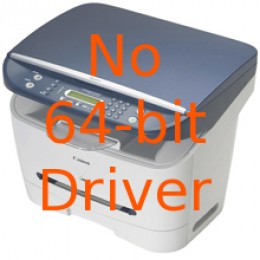Oh Honey, There’s One Thing Missing…
I recently decided to upgrade my wife with a new to 64-bit Windows 7 laptop. Everything went quite smoothly and I had all the applications and data, even the little stuff like bookmarks, moved over and running just great… at least until she decided she needed to print something. “Oh yeah, no sweat! I forgot to add the printer for you!”

Our printer is a Canon MF3110 black and white multifunction laser which is shared off an older Vista computer. We leave it running and use as our home file and printing “server.” Much to my disappointment, I found out that Canon decided not to create 64-bit drivers for that model (as well as a lot of their other printers that are a few years old). Now don’t hear me complaining too loud about Canon. I love a lot of their products and especially that printer, mainly because I can find toner cartridges at ridiculously low prices and it never seems to break down.
After looking around online I saw where someone had done something similar and shared that model of printer from a XP workstation out as a generic postscript printer using the Ghostscript software for a Linux Ubuntu system in order to print to it. I decided I’d try to see if I could do the same thing, but instead share it to the 64-bit Windows 7 laptop. Sure thing, after a bit of tweaking, it worked like a charm!
Here’s what I did:
On my 32-bit computer where my Canon printer is located, I downloaded and installed the following three programs:
Ghostscript Windows 32-bit version:
http://pages.cs.wisc.edu/~ghost/doc/GPL/gpl864.htm
GsView Windows 32-bit version:
http://pages.cs.wisc.edu/~ghost/gsview/get49.htm
Redmon Port Redirector:
http://www.is-foehr.de/
I didn’t really do anything custom or special during the installs. I just let them run their course.
Again, on the same computer where the Canon printer is, I added a new local printer. I named it something generic like Canon64b, (and then here’s the first tricky part) on the very next screen I selected “Create a new port” and selected “Redirected Port” and named it “RPT1:” which should be the default. Then for the model and driver of the printer, I used something really generic “MS Publisher Imagesetter” that should already have drivers on all Windows systems (including 64-bit versions). Then I shared out the printer to “everyone.” The other tricky part was within the Properties of the printer to go to the “Ports” tab and click on the “Configure Port” button for the RPT1 port and set up the correct parameters:
In the “Redirect this port to the program:” field I put in the gsprint program’s location:
C:\Program Files\Ghostgum\gsview\gsprint.exe
For Arguments in the next box down, I put in the name of my real printer which is on the computer like this:
-printer “Canon MF3110” –
Note: is important to include the quotes around the printer, a space and then a dash for this all to work properly.
In the Output area: select “Program handles output” and make sure the printer section is pointing to the real printer. The Run field should be selected as “Hidden”
Then I applied all the changes.
Interactive Hiccup
In order to get it to run without interaction and prevent displaying a confirmation message every time I print a page, I had to copy a registry string value key using regedit
From this location:
HKEY_CURRENT_USER\Software\Microsoft\Windows NT\CurrentVersion\Devices
To this location:
HKEY_USERS\.DEFAULT\Software\Microsoft\Windows NT\CurrentVersion\Devices
The key should be named the same as your real printer and look something similar to this:
Canon MF3110 REG_SZ winspool,Ne03:
After adding the registry key, on my 32-bit computer, I ran a test print from my new virtual Postscript printer and made sure it printed fine.
Then I went to my wife’s laptop and added the new network printer and was able to print… crisis averted and happy wife!
